Korean Compact Is A No-Gimmicks Eco-Warrior
Were we the betting type, we'd put money on looming CAFE standards as the single biggest issue to keep auto execs awake at night. Organizations from the National Highway Transportation Safety Administration to the California Air Resource Board and the Environmental Protection Agency have all made noise about increasing corporate average fuel economy standards to lofty figures that reside anywhere between 47 and 62 mpg in around 14 years – a blink of an eye in terms of product development. If you've been wondering why manufacturers continue to roll out a bevy of fuel-efficient, economical vehicles despite relatively stable fuel prices and luke-warm demand, wonder no more.
Hyundai, with its small-engined fleet of fuel-savvy bruisers, seems downright giddy at the news. The Korean manufacturer has announced that by the time 2025 rolls around, the company will have a corporate average fuel economy of 50 mpg. The groundwork for that dramatic increase is being laid right now with vehicles like the Sonata Hybrid and the most recent addition to the Hyundai stable, the 2011 Elantra.
The last-generation Elantra debuted four short years ago, but in the meantime, competition in the American small-car market has increased by leaps and bounds. Additions like the 2011 Chevrolet Cruze and the upcoming 2012 Ford Focus have proven that domestic manufacturers are just as serious about producing compact, high-quality vehicles with excellent fuel economy as the long-reigning titans of the segment from Honda and Toyota. With its 40 mpg highway rating, stylish exterior and excellent drivetrain, the 2011 Hyundai Elantra is set to put the rest of the segment on notice.
Continue reading...
2011 Hyundai Elantra - Click above for high-res image gallery
Were we the betting type, we'd put money on looming CAFE standards as the single biggest issue to keep auto execs awake at night. Organizations from the National Highway Transportation Safety Administration to the California Air Resource Board and the Environmental Protection Agency have all made noise about increasing corporate average fuel economy standards to lofty figures that reside anywhere between 47 and 62 mpg in around 14 years – a blink of an eye in terms of product development. If you've been wondering why manufacturers continue to roll out a bevy of fuel-efficient, economical vehicles despite relatively stable fuel prices and luke-warm demand, wonder no more.
Hyundai, with its small-engined fleet of fuel-savvy bruisers, seems downright giddy at the news. The Korean manufacturer has announced that by the time 2025 rolls around, the company will have a corporate average fuel economy of 50 mpg. The groundwork for that dramatic increase is being laid right now with vehicles like the Sonata Hybrid and the most recent addition to the Hyundai stable, the 2011 Elantra.
The last-generation Elantra debuted four short years ago, but in the meantime, competition in the American small-car market has increased by leaps and bounds. Additions like the 2011 Chevrolet Cruze and the upcoming 2012 Ford Focus have proven that domestic manufacturers are just as serious about producing compact, high-quality vehicles with excellent fuel economy as the long-reigning titans of the segment from Honda and Toyota. With its 40 mpg highway rating, stylish exterior and excellent drivetrain, the 2011 Hyundai Elantra is set to put the rest of the segment on notice.
Continue reading...
Photos copyright ©2010 Zach Bowman / AOL
In order to mark the 2011 Elantra as part of the family, Hyundai has rolled in a healthy dose of its corporate "fluidic sculpture" design language, though the look isn't quite as overwrought as in the 2011 Sonata. Grafted onto the smaller package, the rounded nose and subdued hexagonal grille give the new Elantra some much-needed character, and that plot is carried down the side of the vehicle thanks to a set of handsome, wrapped headlights and a side strake that runs from the top of the front fender well to the similarly contoured tail lamps. The look is cohesive and well balanced while clearly standing out from the rest of the segment.
Hyundai is offering the 2011 Elantra in just seven buildable configurations to make things easier on both dealers and buyers, and as such, there are only two basic trim packages: GLS and Limited. In GLS guise, the interior of the sedan is treated with attractive cloth seats and a two-tone dash with soft-touch materials up top and well-grained plastic down low. The dash, steering wheel and center stack all boast a taste of the same flowing design as the exterior of the Elantra, and as such, you'll find plenty of complex arches and curves indoors. The look won't be for everyone, but it's a vast improvement over the bland cabin of the last generation.



By pushing the Elantra's wheels to each corner and pulling a few clever packaging tricks, Hyundai has managed to provide an impressive amount of space inside. The company's efforts netted the new compact a mid-size designation from the minds at the EPA, and there's room for full-grown adults both front and rear with plenty of space for knees and elbows.
In Limited configuration, the center stack is dominated by a massive seven-inch touch-screen that hosts controls for navigation, audio and iPod integration. Thanks to XM NavTraffic and NavWeather, buyers can check the status of everything from traffic congestion to stock prices, weather advisories and sports scores. A rear-view camera is also available, though the sedan's visibility hardly warrants the tech. The Limited trim also brings along a 360-watt, six-speaker stereo system with an external amp should you decide to rock your passengers' socks straight off their body.
But the biggest difference between base models and their Limited counterparts is the addition of a liberal leather coating inside. Seating surfaces, both front and rear, are swaddled in a perforated hide with a unique wave pattern, and for the first time in this segment, both front and rear passengers get the joy of heated seats. The thrones are double stitched, though Hyundai skipped the typically eye-catching contrasting thread in favor of a color-matched material.
One of the nicer details in the Elantra interior is the HVAC controls. Designers implemented an intuitive system of stacked dials to control fan speed and temperature, and the system takes little more than cursory glance in order to be able to use without taking your eyes off of the road. The dials feel like quality pieces with nice texturing and a solid action.
Regardless of what trim level buyers decide on, they'll benefit from a drivetrain that merrily returns 29 mpg city and 40 mpg highway. The 2011 Elantra comes with a 1.8-liter four-cylinder engine producing 148 horsepower and 131 pound-feet of torque in ULEV guise. A PZEV variant is also available, but it sacrifices three horsepower and one lb-ft compared to its brethren. The engine is mated to either a six-speed automatic or manual transmission. All told, the engine gives the 2011 Elantra more power and better fuel efficiency than competitors like the Honda Civic, Nissan Sentra, Toyota Corolla and Mazda3.
Despite having a successful direct-injection program, Hyundai opted to go with a traditional multi-point fuel-injection system on the 2011 Elantra, largely to keep vehicle cost as low as possible. Even so, the company implemented a few clever engineering tricks to make the 1.8-liter mill as efficient as possible, including dual constant variable valve timing and an offset crankshaft that the company says helps reduce friction losses. A dual-plane intake and electronic throttle control also pitch in to make the most out of every drop of fuel it sucks down.

But the engine is only part of the sedan's fuel-efficiency story. The Elantra makes use of the new Hyundai six-speed automatic transmission, and the cog-box is no less advanced than the mill it's bolted to. Lighter, more compact and with fewer moving parts than the outgoing five-speed automatic, the transmission is right at home switching gears for the Elantra. Hyundai used a single control unit for both the engine and the transmission to improve smoothness, and the computer will actually cut juice to the four-cylinder between shifts to increase fuel economy.
We were fortunate enough to spend time in both the Elantra GLS with the six-speed manual transmission and an Elantra Limited with the six-speed automatic, and – as much as it pains us to say – the automatic-equipped vehicle is far and above the better driver. Both cars deliver a remarkably quiet cabin thanks to a three-layer door system and heaps of insulating foam in the vehicle's body cavities. A set of hydraulic engine mounts do a smart job of keeping any vibration from the engine out of the cabin, and more than once we found ourselves wondering whether or not the four-pot was actually running at idle.
Hyundai may have styled the 2011 Elantra with something of a sporty bent, but make no mistake: This isn't a compact corner carver. The good news is that the automaker isn't trying to paint the vehicle as the next great gift to motorsport. If we're looking for something that's fun to fling, we're told to wait for the 2012 Veloster. Instead, you're greeted with a very comfortable, very capable commuter from behind the wheel. Steering is a little on the light side thanks to the fuel-saving electric-motor power steering on board, but it provides more feedback than the 2011 Sonata Turbo.




The vehicle's suspension is appropriately tuned for comfortable commuting, managing to hit that Goldilocks sweet spot of neither too soft nor too firm for fielding broken pavement or the occasional twist in the tarmac. Up front, the Elantra is equipped with a MacPherson strut design with a 23 millimeter sway bar, while the rear makes use of a torsion-beam set up.
When equipped with the manual transmission, long gear ratios keep the Elantra from feeling as peppy as its automatic-equipped counterpart. The clutch is predictably soft for a vehicle that's more comfortable fielding the morning commute than carving canyons, and the piece provides a much more linear release than its corporate cousin, the Kia Forte. The friction point is miraculously forgiving, making the Elantra an appealing option for those new to the third pedal. The shifter is also surprisingly precise, providing a tactile notch to let you know exactly when you've landed the next gear.
That said, after ducking behind the wheel of the automatic-equipped Limited, we had a hard time finding an argument for the row-your-own Elantra. Shifts from the six-speed automatic are surprisingly quick and smooth for a vehicle in this price range. Slightly shorter gearing and the transmission's ability to keep the engine in its power band at all times make for a compact that feels much quicker than its horsepower should allow. It's a completely different world from its manual-transmission counterpart.
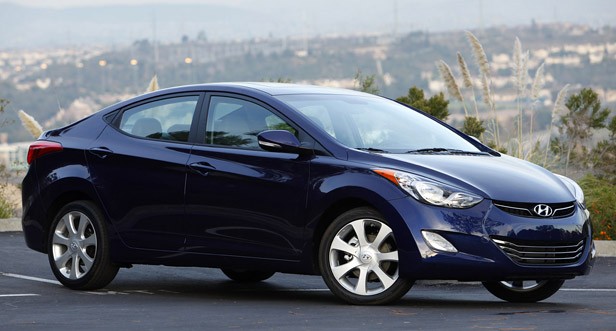



Like most automatics, the Elantra provides a manumatic mode, but, unlike most of the gimmicks on the market, this one is actually worth playing with. Bump the shifter up to gain a gear or back to lose one, and the gearbox shifts quicker than the time it takes your right hand to get back to the steering wheel. It's not quite dual-clutch quick, but it's faster than just about any other system we've played with.
The 2011 Elantra comes with disc brakes on all four corners as standard equipment, and as such, Hyundai says that it has a shorter stopping distance than either the Civic or the Corolla, both of which only offer rear discs on higher trim levels. The stoppers are more than capable of scrubbing speed, even after heavy abuse through the rolling terrain surrounding San Diego, and the system delivers a firm pedal with very little fade.
Our drive route landed us on both stints of interstate and winding back-country roads, and while our seat time was too short to get a good idea of exactly what kind of fuel economy we could expect in regular driving, we saw between 34 and 35 mpg over the course of the day. Those numbers line up pretty well with the EPA's 29 mpg city and 40 mpg highway, so we're interested to see exactly what the car can return over a full week's worth of drive time.
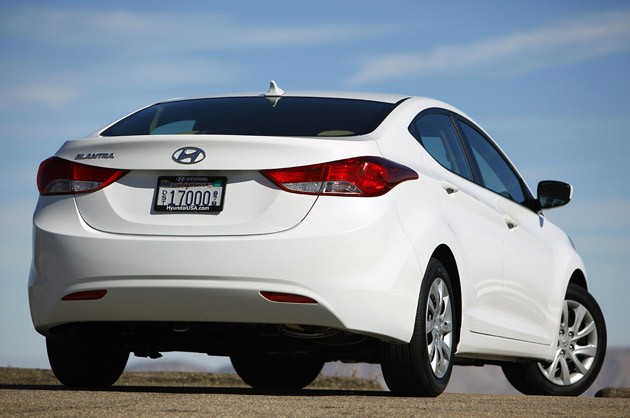
Hyundai began selling the Elantra this month, and technically, you can drive away with a base GLS with a manual-transmission for $14,830, though expect to make a few sacrifices at that price point. The bottom-of-the-line Elantra doesn't come with creature comforts like air-conditioning, though power windows and power locks are standard equipment. The vast majority of buyers are more likely to opt for the GLS with what Hyundai calls the "Popular Package." Alongside frosty A/C, the equipment package throws in cruise control and a telescoping steering column for $16,080. For an extra grand, buyers can have that excellent automatic gearbox and 16-inch alloy wheels instead of the 16-inch steelies and wheel covers on the manual-transmission vehicle.
For all of the buzz surrounding electric vehicles and extended-range hybrids at the moment, Hyundai believes that even 15 years from now, the technology is still going to carry a cost-prohibitive price tag, relegating those vehicles to a fairly small portion of the overall automotive market. If that turns out to be the case, we can expect to see more vehicles like the 2011 Elantra appear in the near future, packing plenty of content and a quality driving experience with ever-increasing fuel economy.
With the next-generation Honda Civic and 2012 Ford Focus on the horizon, the 2011 Hyundai Elantra will be facing some stout competition in the future, but right now, the little sedan has the bones to be king of the compact roost.
Photos copyright ©2010 Zach Bowman / AOL

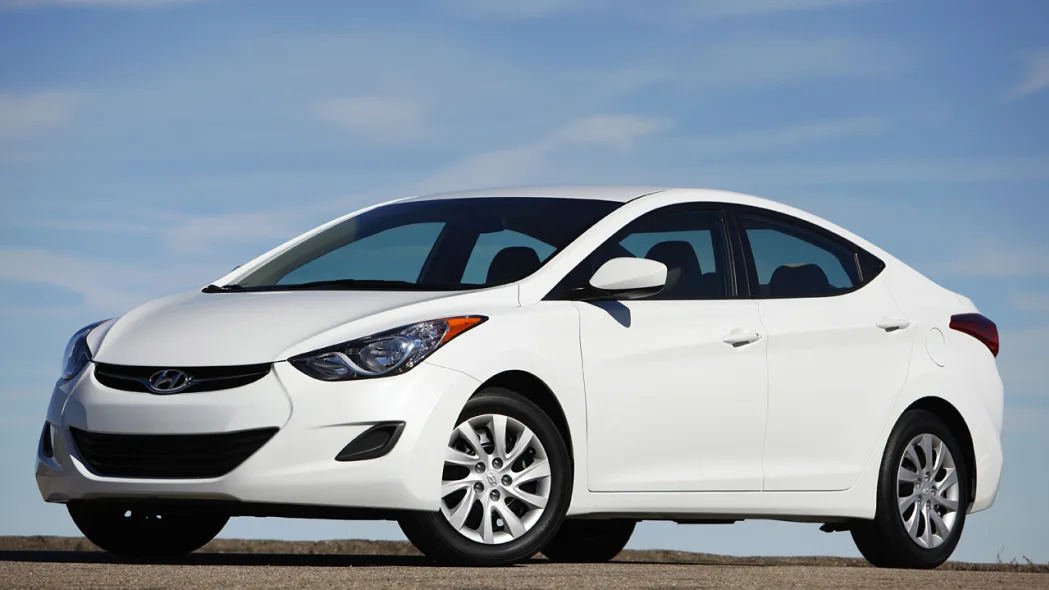
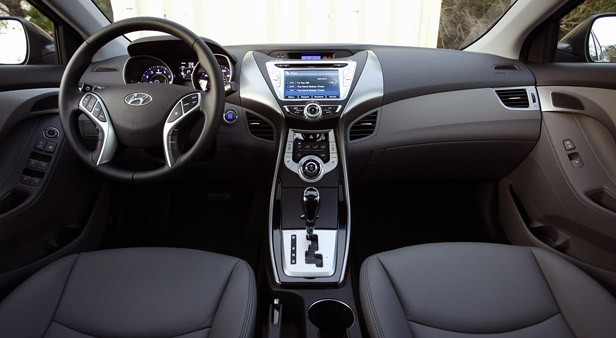



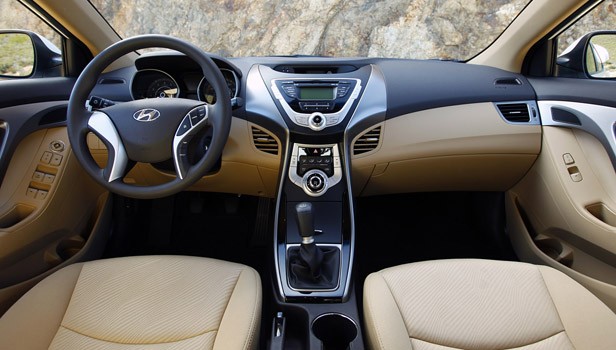




Sign in to post
Please sign in to leave a comment.
Continue